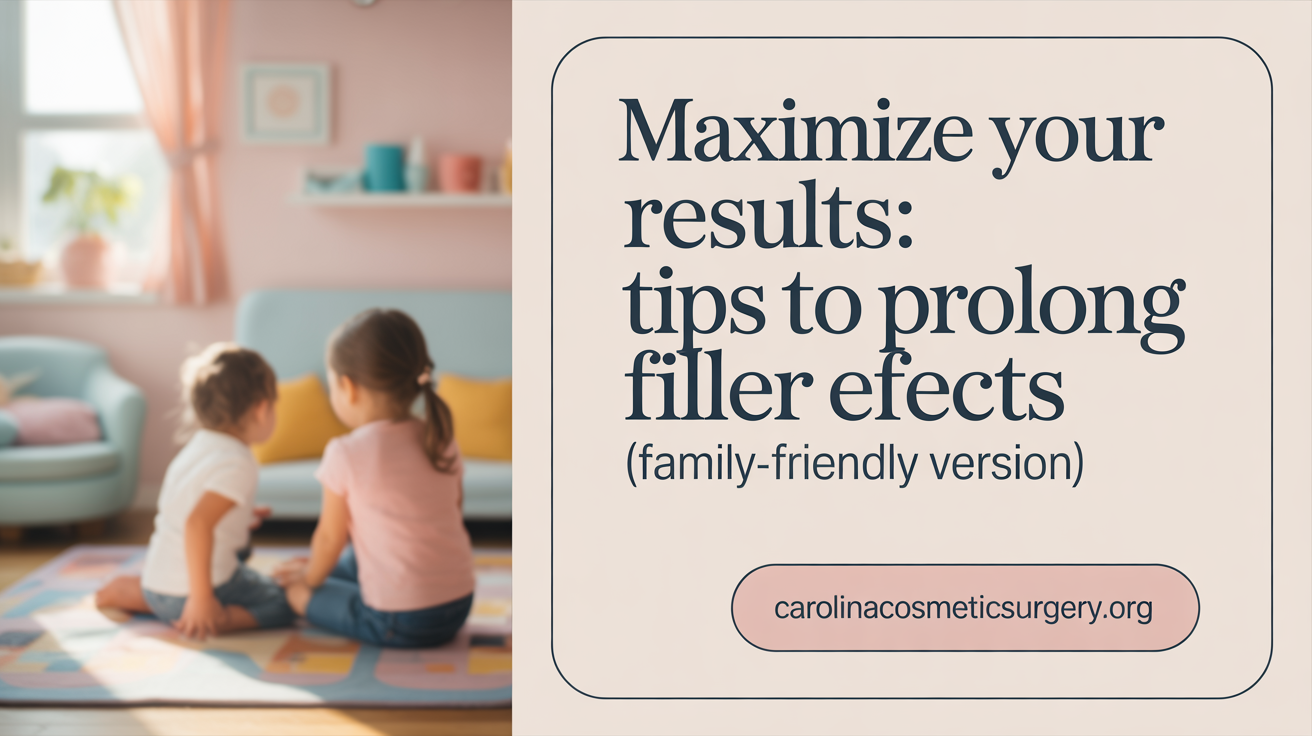Understanding How Long Dermal Fillers Really Last
Cosmetic dermal fillers have surged in popularity as a non-surgical method to restore facial volume, smooth wrinkles, and rejuvenate skin. However, many patients seek clarity on how long these treatments truly last, the factors influencing their lifespan, and what to expect as their effects diminish. This article explores the typical duration of various types of dermal fillers, scientific insights into their longevity, individual influences on their effectiveness, and expert advice on maintaining results, providing a comprehensive understanding for those considering or maintaining filler treatments.
Typical Lifespan and Types of Dermal Fillers
What is the typical lifespan of cosmetic dermal fillers?
The duration of dermal filler effects varies depending on the type used, the area of treatment, and individual metabolism. Generally, hyaluronic acid (HA) fillers last from 6 to 18 months, gradually being broken down by the body's natural processes. For example, Juvederm and Restylane typically maintain results within this period. Calcium hydroxylapatite (CaHA) fillers like Radiesse tend to last around 12 to 18 months, stimulating collagen production. Poly-L-lactic acid (PLLA) fillers, such as Sculptra, can last over two years as they promote collagen growth over time. Some fillers are designed to be permanent or semi-permanent, like polymethylmethacrylate (PMMA) which can last more than five years.
Differences in longevity among filler types
The longevity differences are primarily based on material composition. Hyaluronic acid fillers are temporary, with effects generally lasting 6 to 12 months, as they are gradually metabolized. Denser, cross-linked HA formulations can last longer. Semi-permanent options, like PLLA, extend results through collagen stimulation, often lasting up to two years. Calcium hydroxylapatite provides a longer-lasting effect than HA, with effects up to 18 months. Permanent fillers, such as PMMA, contain microspheres that provide support indefinitely, offering permanent results but with higher potential risks. The choice depends on patient goals, the area treated, and the desired duration.
Examples of filler durations
| Filler Type | Typical Duration | Examples and Notes |
|---|---|---|
| Hyaluronic Acid (HA) | 6-18 months | Juvederm Ultra, Restylane Silk/ Lyft |
| Calcium Hydroxylapatite | Up to 18 months | Radiesse |
| Poly-L-lactic Acid | Over 2 years | Sculptra |
| Polymethylmethacrylate | 5 years or more | Bellafill |
Are some fillers permanent?
Yes, some dermal fillers are designed to last indefinitely. Polymethylmethacrylate (PMMA) microspheres, found in products like Bellafill, are considered semi-permanent or permanent depending on the formulation and application. These fillers are not biodegradable and provide ongoing support, requiring only a single injection. While they offer long-lasting results, their permanence raises caution, as complications can be more difficult to address if undesirable outcomes occur. Such fillers are typically reserved for specific cases with extensive discussion with a qualified medical professional.
Factors Influencing Dermal Filler Longevity
 The lifespan of dermal fillers depends on several interrelated factors, including the type of filler used and the area treated.
The lifespan of dermal fillers depends on several interrelated factors, including the type of filler used and the area treated.
Filler Type Impact: Different formulations have varying durations. Hyaluronic acid (HA) fillers, such as Juvederm and Restylane, typically last between 6 to 18 months, while more durable options like poly-L-lactic acid (Sculptra) can last up to 2 years or more. Calcium hydroxyapatite (Radiesse) generally persists around 12 to 18 months, and semi-permanent options like polymethylmethacrylate (PMMA) can last five years or longer.
Treatment Area Differences: The location of injection influences how long fillers last. Areas with less movement, like the cheeks or temples, tend to hold filler results longer due to reduced mechanical stress. Conversely, regions with high activity, such as lips or around the eyes, experience faster breakdown due to constant muscle activity.
Individual Metabolic and Lifestyle Factors: Each person's metabolism plays a critical role. Individuals with faster metabolism tend to break down fillers quicker, reducing the duration. Lifestyle habits such as smoking, sun exposure, and skincare routines also affect how long fillers remain visible. Maintaining good skin health and avoiding damaging behaviors can help prolong effects.
Injection Technique and Volume: Skilled practitioners optimize the placement and volume of filler injections, which can influence longevity. Larger volumes and precise layering in strategic areas may yield longer-lasting results. Additionally, consistent touch-up treatments and proper aftercare further extend the benefits.
Additional Influences: Age, skin quality, and ongoing skin care routines also contribute. Younger, healthier skin tends to support longer filler duration, whereas skin that has experienced significant aging or damage may see faster degradation.
By understanding these factors, patients and practitioners can tailor treatments for longer-lasting results, ensuring aesthetic goals are maintained over time.
What Happens When Fillers Wear Off and Potential Risks

What happens when dermal fillers wear off and how long does this process take?
When dermal fillers are no longer active, the body naturally begins to break down and absorb the substances. This process, called metabolization, results in a gradual reduction of volume and effect. For hyaluronic acid (HA) fillers—a common type used for smoothing wrinkles and adding fullness—this breakdown typically occurs within 6 to 18 months. Recent evidence even suggests that residual HA components can linger in the body for years, confirmed by MRI scans showing remnants 2.5 years post-injection.
The body's enzymes, especially hyaluronidase, facilitate this gradual breakdown, allowing for a gentle reversal of the filler’s effects. The duration varies significantly depending on the filler material, application area, and individual metabolism. While some fillers disappear relatively quickly, others, especially thicker or more cross-linked ones like poly-L-lactic acid or polymethyl methacrylate, can last longer, sometimes several years. The longevity depends on factors such as the type of filler, the injection technique, and the specific facial area treated.
Do dermal fillers cause any long-term negative effects such as aging the face?
Properly administered fillers do not inherently cause long-term aging of the face. They are primarily used to restore volume, lift sagging features, and diminish signs of aging, helping individuals maintain a youthful appearance. However, inconsistent or excessive use—such as overfilling or repeated treatments—can lead to undesirable outcomes like a distorted or unnatural look, which some might perceive as premature aging.
In certain cases, improper technique or lack of comprehensive skin care can contribute to sagging or uneven features over time. Additionally, filler migration or accumulation of residual material might cause subtle changes, but these are often manageable with professional intervention. When used responsibly by qualified practitioners, fillers generally support a natural aging process, functioning as tools to enhance facial harmony rather than accelerate aging.
What are the risks and downsides of using dermal fillers?
Although dermal fillers are considered safe when administered correctly, they do carry some risks. Common side effects include temporary swelling, bruising, redness, tenderness, itching, and mild pain at the injection site. These typically resolve within a few days.
More serious complications can occur, particularly if the filler is injected into or near blood vessels. This can result in tissue ischemia, necrosis, or even vision problems like blindness if the blood supply to vital areas is compromised. Allergic reactions, although rare, may also happen, especially with certain additives or products. Nodules or granulomas can develop as a foreign body response.
The risk of adverse effects increases with unqualified or inexperienced practitioners, unregulated products, or improper injection techniques. To maximize safety, it’s crucial to undergo treatments with licensed healthcare providers who utilize approved, high-quality products. Proper patient assessment, technique, and post-treatment care help minimize these risks and improve aesthetic outcomes.
Scientific Insights: Medical Studies and Imaging on Filler Longevity
Are there medical studies or imaging techniques that inform us about the longevity of dermal fillers?
Yes, advanced imaging technologies like Magnetic Resonance Imaging (MRI) have played a significant role in understanding how long dermal fillers last in the body. MRI scans have been able to detect residual filler material years after initial injection, providing evidence that some hyaluronic acid (HA) fillers can persist well beyond the commonly estimated 6 to 12 months.
One notable finding is that HA fillers have been observed in patients even 2.5 years after their procedures, as confirmed by MRI imaging. This challenges prior assumptions that these substances are fully metabolized within a year.
The use of MRI not only visualizes the presence and size of the fillers but also helps in assessing their stability, location, and any potential complications such as residual material acting as a reservoir for bacteria, which could lead to delayed infections.
Furthermore, imaging studies help clinicians understand how factors like injection area, product formulation, injection depth, and particle size influence how long the filler remains visible and effective. For example, denser, highly cross-linked products tend to show longer persistence, especially in less mobile areas.
Overall, scientific research employing MRI demonstrates that certain dermal fillers, particularly HA-based ones, may last much longer than traditional estimates suggest, influencing how treatment plans are devised. Knowing that fillers can stick around for years also informs decisions regarding procedures, potential risks, and the timing of repeat treatments.
In summary, MRI studies on dermal fillers reveal that long-term retention is possible, highlighting the importance of imaging in both evaluating outcomes and planning future procedures.
Best Practices and Tips to Maximize Filler Duration
What tips and best practices can help extend the effects of dermal fillers?
Maximizing the longevity of dermal fillers involves a combination of good skin care, healthy lifestyle choices, and careful post-treatment habits. To start, incorporating regular moisturizing with hyaluronic acid-based products can help maintain skin hydration and support filler effects. Using antioxidants like Vitamin C and applying a broad-spectrum sunscreen with SPF 30 or higher protect the skin from UV damage, which can degrade filler over time.
Healthy habits are equally important. Staying well-hydrated, eating a balanced diet low in sugar, managing stress, and getting sufficient sleep can all contribute to longer-lasting results. Avoiding smoking and limiting alcohol intake can prevent premature skin aging and help maintain the filler’s efficacy.
Post-treatment care plays a vital role in preserving results. Patients should refrain from vigorous facial movements, avoid touching or massaging the treated areas, and apply ice to reduce swelling. Sleeping on the back with an elevated head position minimizes pressure on the face. Additionally, avoiding strenuous activities and heat exposure from hot showers or saunas for at least two weeks after treatment can help delay the breakdown of fillers.
Regular maintenance treatments or touch-ups with a skilled practitioner ensure that the results remain consistent and natural over time. Creating a personalized treatment plan with your injector allows for adjustments based on how your skin responds and your desired outcomes.
In conclusion, a combination of diligent skincare, healthy lifestyle choices, and professional maintenance can effectively extend the time dermal fillers last, helping you enjoy their youthful effects longer.
Final Thoughts on Cosmetic Filler Duration and Care
The duration of cosmetic dermal fillers varies widely based on filler type, treatment area, metabolism, and individual lifestyle factors. Temporary fillers like hyaluronic acid commonly last six to eighteen months, while biostimulatory fillers and permanent options provide longer-lasting or indefinite results. Scientific imaging reveals that some fillers may persist much longer than traditionally believed, emphasizing the importance of considering long-term effects and risks. Patients can optimize the longevity and aesthetic outcomes of their treatments through careful product selection, expert injection techniques, diligent skin care, and healthy lifestyle choices. Understanding these factors enables informed decisions and helps maintain youthful, natural-looking results over time.
References
- How long do dermal fillers last? | American Society of Plastic Surgeons
- How Long Do Dermal Fillers Last? | Boston &Wellesley Hills
- Hyaluronic acid fillers may be longer-lasting than previously described
- How Long Do Injectable Fillers Last? - Dermatology Affiliates
- How Long Do Dermal Fillers Last? - Vujevich Dermatology Associates
- How Long Do Fillers Last? A Guide to Facial Filler Longevity
- How Long Do Dermal Fillers Last? The Definitive Guide
- How Long Do Fillers Last? | The Spa at NAPS - Dr. Amy Alderman
- Longevity Unveiled: How Long Do Dermal Fillers Really Last?
